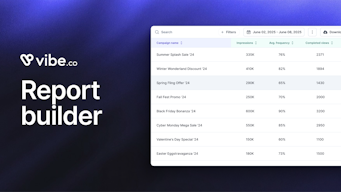What is Video’s View Through Rate (VTR): How do you Calculate It?
Are your video ads genuinely making an impact, or are they quietly draining your budget?
Wouldn’t it be nice to know how well your ads perform on platforms like CTV and OTT?
If that’s been on your mind, you’re in the right place.
This blog is about Video’s View-Through Rate (VTR), a key metric that shows how many people are actually watching your ads.
Why does VTR matter?
Because it’s a clear signal of how engaging and relevant your ad is. If your vVideo’s VTR is high, it means your audience is hooked. If it’s low, it’s time to rethink your strategy.
Here’s what we’ll cover:
- What is a VTR, and why is it essential for CTV advertising?
- How to calculate your VTR with a simple step-by-step guide.
- A comparison of VTR with metrics like CTR, CPM, and others.
- Why platformstools like Vibe are game-changers for TV ad optimization.
- Actionable tips to improve your VTR and campaign performance.
By the end, you’ll know exactly how to use VTR to create data-driven ad strategies and deliver better results.
What is a Video’s View Through Rate (VTR)?
Your Video’s View Through Rate (VTR) measures the percentage of viewers who watch your video ad from start to finish.
Why is VTR Important for TV Advertising?
When it comes to TV ads, VTRs areis an essential performance metric for various reasons:
- Engagement: A high VTR means your ad is effective enough to keep viewers watching. This indicates good storytelling and creative execution.
- ROI: VTR metrics helps you determine whether your ad spend delivers value by keeping viewers engaged.
Manual and Programmatic Ads
VTR works well with manual placements (where ads are placed directly) and programmatic ads (automated placements). In both cases, tracking VTR helps you optimize campaigns for better results.
Budget Allocation
If certain ads have higher VTRs, you can allocate more of the budget and pause underperforming ones.
As a result, every dollar you spend contributes to better results.
How do you Calculate Video View Through Rrates (VTR)?
Calculating VTR is simple. Use the formula:
VTR = (Total Completed Views / Total Impressions) x 100
For instance, let’s say your video ad received:
- 10,000 impressions
- 4,000 completed views
VTR = (4,000 / 10,000) x 100 = 40%
Now that you understand how to calculate VTR, let’s explore the results you should anticipate for your ads to achieve meaningful engagement.
What is a Good Video’s View Through Rate (VTR)?
A good VTR is generally considered 15% or higher. There are various factors that affect this score. Let’s learn about them.
Factors Affecting VTR:
- Ad Length: Shorter video ads tend to have higher VTRs as they’re easier to watch fully.
- Creative Quality: Engaging visuals and strong messaging keep viewers hooked.
- Targeting: Ads shown to the right audience are more likely to perform better.
How Does VTR Compare to Other Metrics?
VTR vs. VCR (Video Completion Rate)
- VTR measures the percentage of total impressions that result in full views, making it a broader metric.
- Completion Rate, on the other hand, focuses only on viewers who started watching the ad, which can give a narrower perspective on engagement.
VTR vs. Click-Through Rate (CTR)
- CTR tracks how many viewers clicked on your ad, focusing on driving traffic to your website or landing page and is not relevant to Streaming TV ads.
- VTR measures how well your ad keeps viewers engaged throughout, making it ideal for evaluating video performance rather than just click potential.
VTR vs. Cost Per Thousand Impressions (CPM)
- CPM measures the cost of delivering your ad to 1,000 people, focusing on reach and budget efficiency.
- VTR, however, evaluates how engaging your ad is, focusing on the quality of viewer attention rather than just the number of impressions.
- While CPM tells you how far your ad went, VTR tells you how well it performed in engagement.
How to Improve Your VTR with Better Ad Strategies?
Improving VTR isn’t just about luck—it requires strategic planning.
1. Targeting the Right Audience
Reaching the right audience is key to improving your vVideo’s View Through Rate (VTR). The more relevant your viewers are, the more likely they’ll stick around to watch your ad till the end.
This is where Vibe can help you.
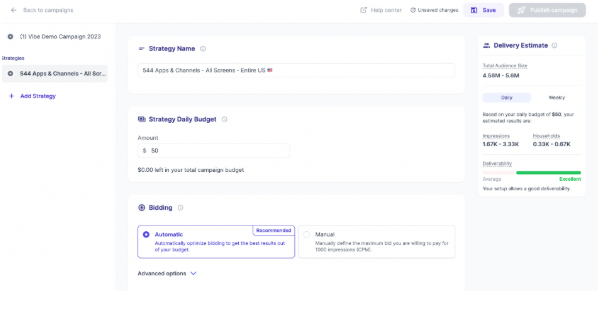
Vibe offers three powerful targeting options to ensure your ads hit the mark:
- By Interest: You can target based on search queries, household income, or political affiliation.
- By Context: You can choose from 500+ channels, specific time slots, or geo-locations like zip codes and cities.
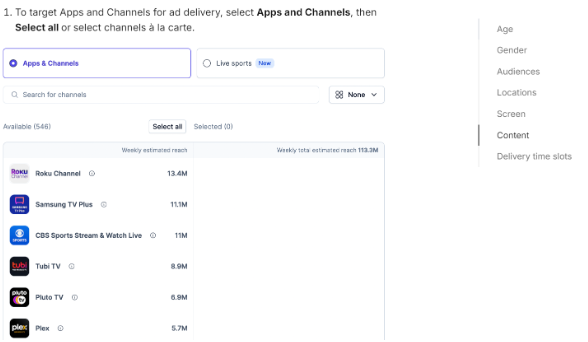
- By Demographics: Focus on age, gender, or family composition for laser-precise campaigns.
Plus, Vibe’s retargeting feature allows you to re-engage website visitors by placing a simple Vibe pixel on your site.
With these tools, Vibe ensures your ads reach the right people, boosting engagement and VTR.
2. Creative Optimization
- Keep your ads visually appealing.
- Deliver your core message within the first few seconds.
- Use storytelling techniques to keep viewers engaged.
3. Testing and Analytics
Platforms like Vibe let you run A/B tests to see which ad variations perform best. Based on what works, you can tweak ad length, visuals, or messaging in real-time..
What Are the Limitations of VTR?
While VTR is a valuable metric, it’s not perfect.
- No Brand Recall: VTR shows if someone watched your ad but doesn’t reveal if they remembered your brand.
- No Broader Engagement: A viewer may complete your ad but not take further action, like visiting your website.
Balancing VTR with Other KPIs
To better understand your campaign's significance, consider monitoring VTR with additional metrics such as CTR, reach, and brand lift.
This will give you a clearer understanding of your ads' performance. Now, let’s explore additional metrics that can influence your marketing objectives.
What Are the Alternatives to Using VTR for TV Ads?
While Video’s View Through Rate (VTR) is an excellent metric for measuring ad engagement, it’s not the only way to evaluate success.
Depending on your campaign goals, other metrics might offer additional insights.
Other Metrics to Consider
- Reach: Measures the number of unique viewers exposed to your ad. This is great for assessing how far your message spreads.
- Frequency: Tracks how many times a single viewer sees your ad. This helps balance visibility without overexposure.
- View-Through Rate (VTR): This indicates the percentage of viewers who watched part of your ad but didn’t necessarily finish it. It's useful for understanding partial engagement.
- CPM (Cost Per Thousand Impressions): This shows how efficiently you’re reaching viewers in terms of cost.
Combined with VTR, these metrics provide a fuller picture of your ad performance.
How Vibe Measures Campaign Performance
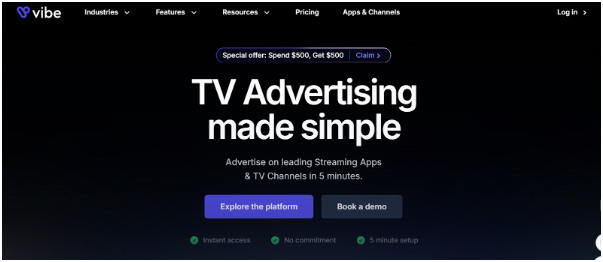
Vibe goes beyond VTR, offering a comprehensive suite of metrics to monitor your campaigns in real time.
Here’s what you can track:
- Impressions: Number of times your ad was shown.
- Completed Views: Tracks the number of viewers who finished your ad.
- CPCV (Cost Per Completed View): Calculates the cost for each completed view.
- View-Through Rate (VTR): Average percentage of your ad viewed.
- Unique Households: Number of unique household IP addresses that saw your ad.
If you’ve implemented Vibe’s web pixel, you can also measure:
- Sessions: Number of interactions on your website.
- Leads and Purchases: Track conversions and assess Cost Per Lead and Cost Per Purchase.
- ROAS (Return on Ad Spend): Understand the revenue generated for every dollar spent.
Vibe allows you to filter performance data by:
- Strategy, Date, Ad, and Channels.
- Geography, Age, Gender, and Audience Segments.
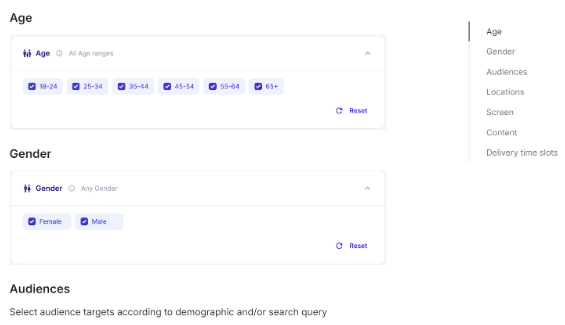
You can download reports or share them with team members to make data-driven decisions.
With Vibe, you’re not limited to VTR—you get a 360-degree view of your campaign’s performance.
Conclusion: How to Use VTR to Make Smarter TV Advertising Decisions
Having covered the importance of Video’s View Through Rates (VTR) in TV advertising, let's highlight the main points we’ve learned.
Improving your VTR is vital for crafting successful advertising campaigns. It allows you to evaluate engagement rates, calculate return on investment (ROI), and adjust your strategies to ensure optimal use of your advertising budget.
Combining VTR with other key metrics, such as CTR, CPM, and audience reach, can help you thoroughly understand your campaign's effectiveness.
To further improve your campaigns, consider leveraging Vibe’s intuitive self-serve ad platform.'.
Vibe simplifies the optimization of TV ads by providing advanced targeting options, real-time performance tracking, and automated reporting.
It is specifically designed to help you increase VTR, improve engagement, and achieve better outcomes from your TV advertising efforts.
With the right tools and strategies, you can elevate your TV marketing initiatives into campaigns that truly resonate with your target audience.

